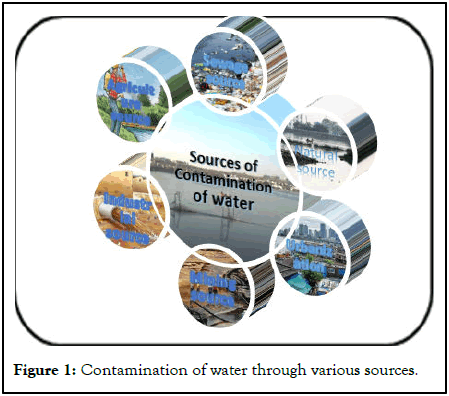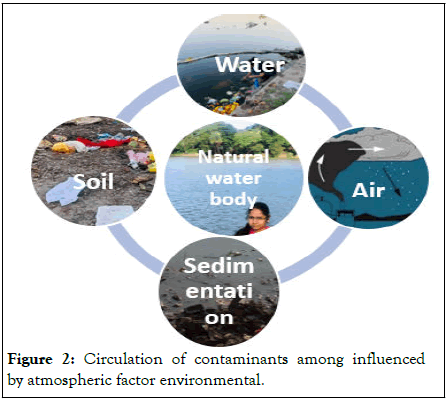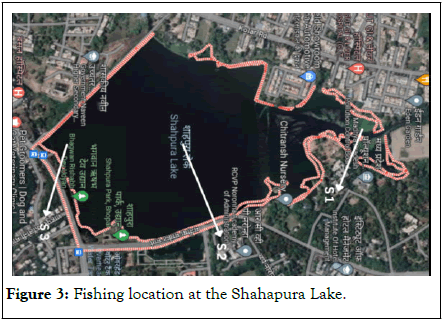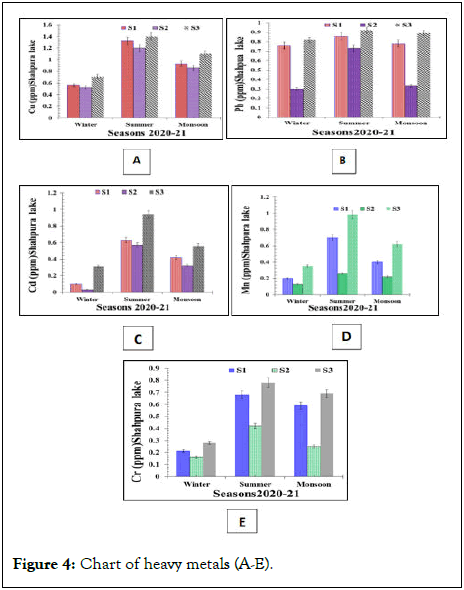Fisheries and Aquaculture Journal
Open Access
ISSN: 2150-3508
ISSN: 2150-3508
Research Article - (2023)Volume 14, Issue 4
A few samples were collected from the three different regions of the selected experimental water body i.e., Shahpura Lake, India. These sites are classified as S1-inlet; S2-centre region and S3-outlet region of the water body, from all these sites, samples were collected during the three different seasons viz., summer, monsoon and winter by using the appropriate methodology to assessed the water parameters like pH, TDS, and conductivity of the lake. In the current study researcher also focused on some selected heavy metals such Pb, Cd, Mn and Cu from the different sampling sites. Here we got the highly significant results (P<0.001) from all the regions of the water body. Due to this, from the present experimental study we came to a conclusion that due to the increased concentration of these heavy metals leads to the sever toxicity in the aquatic fauna of the Lake which directly leads to the various hazardous impact on the human population through the various anthropogenic hindrances in the food chain of the humans. Various minimizing measures were also initiated by the concern authorities to overcome this toxicity up to some extent.
Water parameters; Heavy metal toxicity; Lethal concentration; Bio- magnification; Researcher
The water of Shahpura Lake is severely contaminated due to the heavy discharge of pollutants without proper treatment to remove harmful compounds [1]. This contamination is causing significant damage to both individual species and the overall natural biological community. The present study focuses on the water quality of Shahpura Lake Bhopal, specifically examining parameters such as temperature, chloride, hardness, alkalinity, pH, conductivity, Total Dissolved Solids (TDS), turbidity, Dissolved Oxygen (DO), and Biochemical Oxygen Demand (BOD) [2]. The findings clearly indicate that treatment is necessary before consuming water from Shahpura Lake.
In the present world we existed today is what our past generation left on us, the future generations would inherit the legacy we leave for them [3].” Water is essential for life on earth. Water is a great lifeline, without it, life is impossible [4]. Water the “Elixir of Life” is facing a severe threat in the present scenario due to different types of pollution. Water, due to its great solvent power, is constantly threatened to get easily polluted due to serious problems which today we are facing because all water resources have been reached to a point of crisis due to unplanned urbanization and industrialization [5]. Water pollution refers to any type of aquatic contamination rendering the water body poisoned by toxic chemicals, which affect living organisms and all forms of life. Heavy metals constitute an important group of environmentally hazardous substances. During this century, many lakes in India have received elevated inputs of heavy metals as a result of an increase in atmospheric deposition [6]. To study the extent of pollution in surface water bodies, we have selected the Shahpura Lake, which is situated in one of the most populated region of Bhopal, the capital city of Madhya Pradesh state in India. It receives domestic raw sewage from surrounding habitation; due to many anthropogenic activities which paves the way for high concentration of hazardous chemicals in the water body [7]. The domestic waste water contributes the largest source of heavy metal concentration in the lake, so it is expected that this reservoir can serve as a model for studying heavy metal concentration which is responsible for adding pollution load in the lake. The idols are being made up of clay, hay, cloth, paper, wood, bamboo, thermo coal, adhesive material, paints, colored pigments etc. Apart from it a large number of heavy metals are contributed by corrosion of metal pipes [8]. Run-off waters from surroundings during rainy season the percolation of various heavy metals like Cu, Cr, and Pb etc. The discharge of heavy metals in the environment has much obvious impact on aquatic life of water body. There may be an increase in residue levels in water, sediments and biota, decreased productivity and increase in exposure of humans to harmful substances. Prapurna Naga carried out the analysis of heavy metal ions present in the lake water of Hussain Sagar Lake and found that the very presence of various heavy metal ions in their dissolved state, are hindering the beneficial uses of the lake waters [9]. The area under study having Latitude 230 12’ 00" E and Longitude 770 25’ 30" N enjoys a sub-tropical climate with pronounced summer, winter and rainy seasons [10]. The lake, in most parts is muddy due to the accumulation of silt but towards the northwestern side, it has hard and clayey substratum. The main inlet is the Nallah joins the lake at its northern end [11].
The source of contamination in water
Due to rapid industrialization and a consumerist lifestyle, there has been a significant increase in sources of environmental pollution [12]. This pollution occurs during industrial production and also during the end use of products and run-off. Consequently, these toxic elements primarily enter the human body through food and water, and to a lesser extent through inhalation of polluted air, the use of cosmetics, drugs, and poorquality herbal formulations (Figures 1-3).

Figure 1: Contamination of water through various sources.

Figure 2: Circulation of contaminants among influenced by atmospheric factor environmental.

Figure 3: Fishing location at the Shahapura Lake.
Shahpura Lake faces significant anthropogenic stress due to the heavy influx of sewage and domestic waste [13]. The local inhabitants rely on the lake water for drinking purposes, while also utilizing it for fisheries and various recreational activities. To assess the lake's condition, the study period of one year was divided into three seasons: Summer, Winter, and monsoon, spanning from December 2020 to December 2021. The water samples were carefully analyzed according to the procedures outlined by APHA [14]. Various parameters such as temperature, DO, pH, TDS, air temperature, water temperature, etc. were regularly examined, along with the selective heavy metals. To ensure accurate heavy metal analysis, the samples were preserved by introducing 5 mL concentrated nitric acid into one liter of sample, maintaining the pH below 4.0, as recommended by Agemian and Chau [15]. The samples were carefully filtered using Whatmann filter paper No. 40. The resulting filtrate was immediately utilized for analysis in the atomic absorption spectrophotometer (Shimadzu, Japan). Prior to sampling, the samples were acidified in accordance with the standard, internationally recognized method recommended by APHA.
Monitoring the lake water is crucial in understanding the trend pattern of pollutants and their impact on living systems in our modern society. The study focused on various physico-chemical characteristics including water temperature, conductivity, Total Solids (TS), pH. The results for these physico-chemical and heavy metals parameters are presented in Tables 1 and 3, while the positive correlation coefficients can be found in Tables 2 and 4. It was observed during the course of the study that in the Summer, Winter and monsoon season, due to the higher velocity of the lake during, excess runoffs, industrial effluents, discharge sewage and using pesticides there is an increase in some important physio-chemical properties during the year of 2020-2021 correlation with the observed results from the selected sites of the water body and the study comprised of the accuracy of (SD=0.01) among all the seasons. These include total solids, a decrease in dissolved oxygen, and an increase in biochemical oxygen demand, chemical oxygen demand, and water hardness. The various chemicals and detergents used for bathing and washing. These activities have a detrimental impact on the chemical composition of the lake, as well as the well-being of aquatic life, which also directly incorporate the disturbance in the secondary food chain results in the toxicity for the human population.
| Air temp. (°C) | Water temp. (°C) | pH | Conductivity (µS/cm) | DO (mg/l) | BOD (mg/l) | NO3 (mg/l) | Cl-(mg/l) | Total hardness (mg/l) | Total alkalinity (mg/l) | TDS (mg/l) |
|---|---|---|---|---|---|---|---|---|---|---|
| 20 ± 0.1 | 19 ± 0.8 | 7 ± 0 | 653 ± 0.6 | 6 ± 0.4 | 1 ± 0.3 | 6 ± 0.8 | 47 ± 0.1 | 118 ± 0.5 | 232 ± 0.6 | 300 ± 0.3 |
| 16 ± 0.9 | 15 ± 0.6 | 7 ± 0.4 | 640 ± 0.3 | 4 ± 0.8 | 2 ± 0.1 | 5 ± 0.2 | 38 ± 0.2 | 105 ± 0.2 | 210 ± 0.4 | 266 ± 0.1 |
| 18 ± 0.8 | 16 ± 0.7 | 6 ± 0.2 | 690 ± 0.4 | 3 ± 0.8 | 2 ± 0.8 | 7 ± 0.7 | 49 ± 0.3 | 189 ± 0.7 | 328 ± 0.1 | 330 ± 0.6 |
| 30 ± 0.6 | 28 ± 0.5 | 6 ± 0.5 | 762 ± 0.7 | 5 ± 0.4 | 1 ± 0.9 | 3 ± 0.9 | 25 ± 0.6 | 218 ± 0.3 | 155 ± 0.5 | 385 ± 0.2 |
| 26 ± 0.3 | 22. ± 08 | 6 ± 0.9 | 648 ± 0.6 | 4 ± 0.6 | 2 ± 0.6 | 3 ± 0.0 | 21 ± 0.3 | 190 ± 0.5 | 147 ± 0.1 | 340 ± 0.4 |
| 29 ± 0.5 | 27 ± 0.9 | 5 ± 0.8 | 760 ± 0.3 | 3 ± 0.2 | 2 ± 0.9 | 5 ± 0.9 | 28 ± 0.2 | 284 ± 0.3 | 162 ± 0.3 | 490 ± 0.7 |
| 26 ± 0.4 | 23 ± 0.5 | 6 ± 0.5 | 680 ± 0.5 | 4 ± 0.6 | 2 ± 0.8 | 4 ± 0.9 | 3 ± 06.1 | 252 ± 0.2 | 217 ± 0.5 | 355 ± 0.2 |
| 19 ± 0.6 | 18 ± 0.8 | 7 ± 0.6 | 653 ± 0.6 | 4 ± 0.9 | 2 ± 0.6 | 4 ± 0.5 | 33 ± 0.1 | 230 ± 0.2 | 171 ± 0.2 | 310 ± 0.1 |
| 27 ± 0.2 | 24 ± 0.7 | 6 ± 0.6 | 738 ± 0.4 | 4 ± 0.4 | 3 ± 0.1 | 6 ± 0.2 | 39 ± 0.3 | 278 ± 0.6 | 298 ± 0.1 | 452 ± 0.6 |
Table 1: Shahpura lake water sampling characteristics at study location (accuracy of data, SD=0.01) (2020-2021).
| Air Temp. (°C) | Air Temp. (°C) | pH | Conductivity (µS/cm) | DO (mg/l) | BOD (mg/l) | NO3 (mg/l) | Cl-(mg/l) | Total hardness (mg/l) | Total alkalinity (mg/l) | TDS (mg/l) | |
|---|---|---|---|---|---|---|---|---|---|---|---|
| Air temp. (°C) | 1 | ||||||||||
| Air temp. (°C) | 0.982666 | 1 | |||||||||
| pH | -0.6104 | -0.59009 | 1 | ||||||||
| Conductivity (µS/cm) | 0.775917 | 0.811925 | -0.75097 | 1 | |||||||
| DO (mg/l) | -0.23306 | -0.16608 | 0.595514 | -0.38543 | 1 | ||||||
| BOD (mg/l) | 0.281237 | 0.183219 | -0.39377 | 0.296178 | -0.85408 | 1 | |||||
| NO3 (mg/l) | -0.39155 | -0.33876 | -0.34217 | 0.108163 | -0.15492 | 0.024778 | 1 | ||||
| Cl-(mg/l) | -0.65467 | -0.62071 | 0.036333 | -0.25038 | 0.165659 | -0.16376 | 0.884897 | 1 | |||
| Total hardness (mg/l) | 0.714403 | 0.69454 | -0.55138 | 0.690949 | -0.58834 | 0.758128 | -0.09076 | -0.36249 | 1 | ||
| Total alkalinity (mg/l) | -0.38294 | -0.41803 | -0.19488 | 0.001241 | -0.13392 | 0.23046 | 0.818158 | 0.853721 | -0.04947 | 1 | |
| TDS (mg/l) | 0.808438 | 0.819692 | -0.75188 | 0.870888 | -0.56399 | 0.54844 | 0.073785 | -0.33073 | 0.842536 | -0.03063 | 1 |
Table 2: Correlation between water quality.
| Seasons | Sample code | Cu (mg/l) | Pb (mg/l) | Cd (mg/l) | Mn (mg/l) | Cr (mg/l) |
|---|---|---|---|---|---|---|
| Winter | S-1 | 0.56 ± 0.6 | 0.76 ± 0.1 | 0.10 ± 0.1 | 0.20 ± 0.2 | 0.21 ± 0.2 |
| S-2 | 0.52 ± 0.3 | 0.30 ± 0.4 | 0.03 ± 0.6 | 0.13 ± 0.5 | 0.16 ± 0.1 | |
| S-3 | 0.71 ± 0.1 | 0.82 ± 0.6 | 0.31 ± 0.7 | 0.35 ± 0.7 | 0.28 ± 0.5 | |
| Summer | S-1 | 1.32 ± 0.6 | 0.86 ± 0.3 | 0.63 ± 0.3 | 0.70 ± 0.6 | 0.68 ± 0.2 |
| S-2 | 1.20 ± 0.3 | 0.73 ± 0.1 | 0.57 ± 0.5 | 0.26 ± 0.3 | 0.42 ± 0.3 | |
| S-3 | 1.40 ± 0.6 | 0.92 ± 0.6 | 0.94 ± 0.4 | 0.98 ± 0.5 | 0.78 ± 0.6 | |
| Monsoon | S-1 | 0.93 ± 0.6 | 0.78 ± 0.1 | 0.42 ± 0.2 | 0.40 ± 0.1 | 0.59 ± 0.1 |
| S-2 | 0.86 ± 0.3 | 0.33 ± 0.6 | 0.32 ± 0.6 | 0.22 ± 0.6 | 0.25 ± 0.3 | |
| S-3 | 1.10 ± 0.1 | 0.89 ± 0.7 | 0.56 ± 0.2 | 0.62 ± 0.1 | 0.69 ± 0.5 |
Table 3: Seasonal variation heavy metals at different stations of Shahpura Lake during 2020-21.
| Parameter | Cu | Pb | Cd | Mn | Cr |
|---|---|---|---|---|---|
| Cu | 1 | ||||
| Pb | 0.577856 | 1 | |||
| Cd | 0.964654 | 0.648614 | 1 | ||
| Mn | 0.815436 | 0.70175 | 0.890941 | 1 | |
| Cr | 0.878599 | 0.726792 | 0.894813 | 0.912469 | 1 |
Table 4: Correlation between heavy metals.
The study conducted by Mahatre et al., [16] reveals that industrial pollution has led to the deterioration of water quality and subsequent impacts on the ecosystem in the Shahpura Lake. The qualitative analysis demonstrates that the lake is exposed to various adverse conditions, including high total solids, turbidity, suspended particulates, presence of heavy metal particulates, and high inorganic and organic load (Figures 4 (A-E)).

Figure 4: Chart of heavy metals (A-E).
The present research is carried out for water quality in the Shahpura lake of Bhopal (India). The water quality parameters for three seasons of Shahpura. The concentration of lead, copper, cadmium, manganese, and chromium were present in lake may cause harm to aquatic animals and human beings via food chain and their bio magnification will lead to various types of diseases in them. Mitigation measures adopted by the concerned authorities may help in maintaining the health of the lake.
[Crossref] [Google Scholar] [PubMed]
[Crossref] [Google Scholar] [PubMed]
[Crossref] [Google Scholar] [PubMed]
[Crossref] [Google Scholar] [PubMed]
[Crossref] [Google Scholar] [PubMed]
Citation: Yadav V, Kumar L, Dixit M, Jangu S, Sundramurthy S (2023) Assessment of Water Quality and Heavy Metals Pollution of Shahpura Lake in Bhopal, India. Fish Aqua J. 14:345.
Received: 24-Aug-2023, Manuscript No. FAJ-23-26262; Editor assigned: 28-Aug-2023, Pre QC No. FAJ-23-26262 (PQ); Reviewed: 11-Sep-2023, QC No. FAJ-23-26262; Revised: 23-Oct-2023, Manuscript No. FAJ-23-26262 (R); Published: 30-Oct-2023 , DOI: 10.35248/2150-3508.23.14.345
Copyright: © 2023 Yadav V, et al. This is an open-access article distributed under the terms of the Creative Commons Attribution License, which permits unrestricted use, distribution, and reproduction in any medium, provided the original author and source are credited.